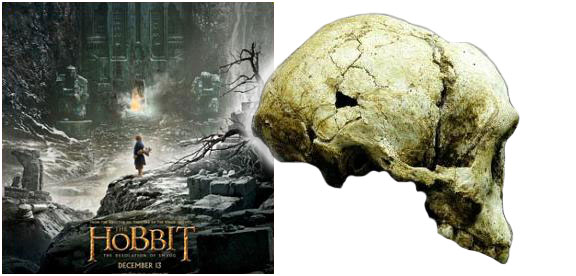 With the upcoming movie release of the second installment of JRR Tolkien’s critically acclaimed “The Hobbit” just upon the horizon – Stony Brook University scientists couldn’t have picked a better time to reveal Hobbits might be more than a literary creation. The classic work of fantasy featuring Hobbits, Dwarves, Elves and magic might be more true to life than we thought.
With the upcoming movie release of the second installment of JRR Tolkien’s critically acclaimed “The Hobbit” just upon the horizon – Stony Brook University scientists couldn’t have picked a better time to reveal Hobbits might be more than a literary creation. The classic work of fantasy featuring Hobbits, Dwarves, Elves and magic might be more true to life than we thought.
The intrigue that Stony Brook researchers have found themselves was prompted by an interesting set of remains that were discovered in Indonesia in 2003. The 18,000 year old remains were initially believed to be Homo sapiens affected with microcephaly, a neurodevelopmental condition marked by a small skull and minuscule brain. But as more and more research is done and measurements are taken, more researchers are believing that the species they nicknamed “Hobbits” must be closer to true than initially believed.
Since the discovery of the species Homo floresiensis, they have constantly been compared to Tolkien’s Hobbits, and not without good reason. Not only did Homo floresiensis stand at a short 3’3” tall, but they also lived in a magical place that rivals Middle Earth for natural wonder. The island of Flores in Indonesia is home to dragons (of the komodo variety) and Kelimutu, a volcano containing three lakes that change colors on an irregular basis, from bright red through green and blue. The island has also recently uncovered remains of another lost species, the stork species Leptoptilos robustus. Estimated to have stood almost six feet tall, it’s not that much of a stretch to imagine Homo floresiensis fearing them as the Hobbits fear the Nazguls’ dark steeds.
It’s fun to compare the fictional race of the Hobbits and their world of dragons, elves and magic to Homo Florensiensis and their amazing island. But is there any reality to the fantasy? Stony Brook University scientists may have the answer. The anthropologists studying the remains used computer imaging and statistics to compare the Homo floresiensis cranium with that of other fossil humans and modern humans with a pathological condition. After running some tests, they found strong evidence that dates the Homo floresiensis skull with extinct fossil human species rather than pathological modern humans.
This brings us to the question that hangs in the air for scientists. Is it possible Homo floresiensis is really its own species? Or could it just be a modern human with some form of pathological condition, resulting in an abnormally small brain and skull?
What’s next for Homo floresiensis? Maybe we’ll find out they had furry feet and ate several meals a day.
Read more about this research on Stony Brook News


Great blog to share. That mystery of Homo Floresiensis found on Liang Bua cave west part of Flores Island, exact on Manggarai regency. I have seen all type of skull after long research of scientist since 2003. I hope that Flores Hobbit will be own species related to their condition and rested of local foods such as Komodo Dragons, big rats and some kind of birds. We are waiting of final information of scientist from around the world. Need time of course to get at all and hope will be